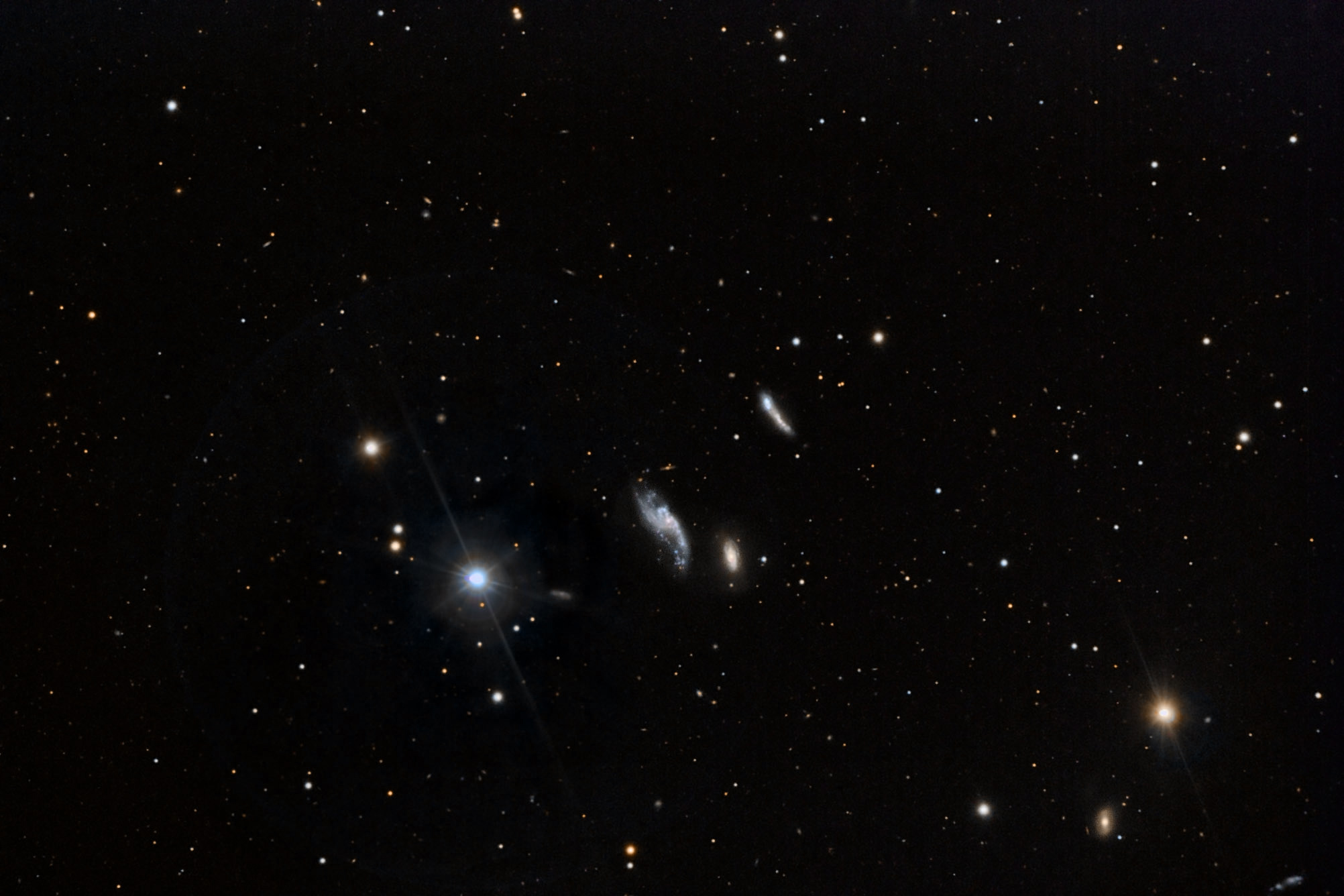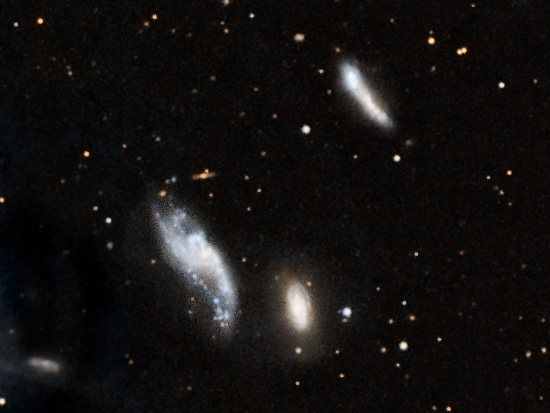| Description | Images |
Object name: ARP313Designation(s): ARP313, NGC3995, NGC3994, NGC3991, ARP 313 is a trio of interacting galaxies. The biggest member in the center is NGC 3995, to the west (right is NGC 3994. The glow-worm like the galaxy to the northwest (upper right) is NGC 3991. Redshift data shows these to be about 150 to 157 million light years from us. NGC 3994, the undistorted one having a redshift that could indicate that it is a good 5 million light years closer thus explaining why it shows so much less distortion. Still, it is a LINER galaxy which indicates something is going on. LINER stands for Low Ionization Nuclear Emission Region. A very complicated way of saying that the core of the galaxy has emission lines indicating there's a lot of gas in the core that is slightly ionized -- that is not many of the electrons are missing but more than you'd expect. The cores of most galaxies are pretty dust and gas free. That is out in the disk of the galaxy where we live. But in galaxies that have interacted with others or that have really active cores due to a hungry black hole, it is seen. Since NGC 3994 doesn't seem to have an active black hole the LINER status would indicate it is feeling the interaction with the other two. Also if you look closely you can see some tidal arms coming off the north and south ends of it. Unfortunately, again taken in moonlight, I can only bring out a hint of this without making the image very noisy. I've attached a crude stretch to show this halo. It appears to connect to NGC 3995 but that is mostly noise from the moon and not real. I need a moon free night to tell more. Related Designation(s):2MASS J11573686+3216397, 2MASS J11574409+3217386, 2MASX J11573685+3216400, 2MASX J11574411+3217389, 2MASXi J1157368+321639, 2MASXi J1157440+321738, 7C 1155+3234, 87GB 115506.6+323354, 87GB[BWE91] 1155+3233, AKARI J1157305+322021, AKARI J1157367+321643, ARK 337, ARP 313, ARP 313 NED01, ARP 313 NED02, ARP313, ASK 527386.0, ASK 527393.0, CALIFA 475, CALIFA 476, CG 0137, CG 0138, CG 0139, CGCG 1154.9+3236, CGCG 1155.0+3233, CGCG 1155.2+3234, CGCG 186-073, CGCG 186-074, CGCG 186-075, ECO 03204, ECO 03206, FBQS J115736.8+321638, FIRST J115736.8+321638, GALEXASC J115736.91+321638.6 , HARO 05, HDCE 0683 NED004, HDCE 0683 NED005, HOLM 309A, HOLM 309B, HOLM 309C, IRAS 11549+3237, IRAS 11550+3234, IRAS F11549+3236, IRAS F11551+3233, KPG 311, KTG 39A, KTG 39B, KTG 39C, KUG 1154+326, KUG 1155+325A, KUG 1155+325B, LDCE 0852 NED006, LDCE 0852 NED007, LGG 259:[G93] 003, LGG 259:[G93] 004, LGG 259:[G93] 005, LQAC 179+032 005, MAPS-NGP O_266_2122379, MCG +06-26-059, MCG +06-26-060, MCG +06-26-061, NGC 3991, NGC 3994, NGC 3995, NGC3991, NGC3994, NGC3995, NVSS J115731+322016, NVSS J115736+321639, PGC 037613, PGC 037616, PGC 037624, RSCG 47:[WBJ2013] A, RSCG 47:[WBJ2013] B, SDSS J115736.86+321639.4, SDSS J115736.87+321639.4, SDSS J115744.09+321738.6, SDSS J115744.10+321738.6, SDSS J115744.16+321738.8, UGC 06933, UGC 06936, UGC 06944, USGC U432 NED01, USGC U432 NED02, USGC U432 NED03, UZC J115731.1+322016, UZC J115736.9+321639, UZC J115744.1+321740, VV 249, VV 249a, VV 249b, VV 523, WBL 366-001, WBL 366-002, WBL 366-003, [BKD2008] WR 428, [DZ2015] 732-02, [DZ2015] 732-04, [M98j] 149 NED03, [M98j] 149 NED04, [M98j] 149 NED05, [RHM2006] SFGs 098, [TTL2012] 120983, [TTL2012] 121667, [VCV2001] J115736.7+321641, [VCV2006] J115736.7+321641, [WB92] 1155+3233, [WGB2006] 115454+32360_b, [WGB2006] 115454+32360_c, |

